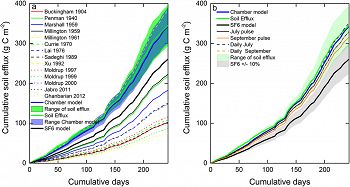Sánchez-Cañete et al., 2017
Improving the accuracy of the gradient method for determining soil carbon dioxide efflux
Sánchez-Cañete E.P., Scott R.L., van Haren J., and Barron-Gafford G.A. (2017)
Journal of Geophysical Research: Biogeosciences 122(1): 50-64
-
Catalina-Jemez, INVESTIGATOR
Abstract
(a) cumulative Fsoil for 14 published empirical models, SF6 model, Chamber model, and its range at 95% confidence interval and mean soil efflux from the chamber and its range. (b) Cumulative Fsoil for the soil efflux chamber and its range, SF6 model ± 10% of error in the injector-sampling distance, Chamber model (obtained using the whole monitoring period), and four models based on two rain pulses (July and September) with continuous monitoring of the Fsoil or with only one daily measurement per day during the rain pulse considered.
Soil CO2 efflux (Fsoil) represents a significant source of ecosystem CO2 emissions that is rarely quantified with high-temporal-resolution data in carbon flux studies. Fsoil estimates can be obtained by the low-cost gradient method (GM), but the utility of the method is hindered by uncertainties in the application of published models for the diffusion coefficient. Therefore, to address and resolve these uncertainties, we compared Fsoil measured by 2 soil CO2 efflux chambers and Fsoil estimated by 16 gas transport models using the GM across 1 year. We used 14 published empirical gas diffusion models and 2 in situ models: (1) a gas transfer model called “Chamber model” obtained using a calibration between the chamber and the gradient method and (2) a diffusion model called “SF6 model” obtained through an interwell conservative tracer experiment. Most of the published models using the GM underestimated cumulative annual Fsoil by 55% to 361%, while the Chamber model closely approximated cumulative Fsoil (0.6% error). Surprisingly, the SF6 model combined with the GM underestimated Fsoil by 32%. Differences between in situ models could stem from the Chamber model implicitly accounting for production of soil CO2, while the conservative tracer model does not. Therefore, we recommend using the GM only after calibration with chamber measurements to generate reliable long-term ecosystem Fsoil measurements. Accurate estimates of Fsoil will improve our understanding of soil respiration's contribution to ecosystem fluxes.
Citation
Sánchez-Cañete E.P., Scott R.L., van Haren J., and Barron-Gafford G.A. (2017): Improving the accuracy of the gradient method for determining soil carbon dioxide efflux. Journal of Geophysical Research: Biogeosciences 122(1): 50-64. DOI: 10.1002/2016JG003530
 This Paper/Book acknowledges NSF CZO grant support.
This Paper/Book acknowledges NSF CZO grant support.
Explore Further


